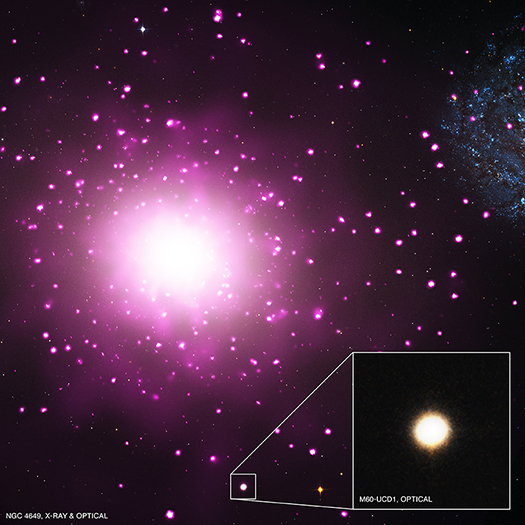A Giant Among Dwarfs

We are very pleased to welcome Jay Strader as a guest blogger today. Jay is the first author of a paper describing evidence for the densest known galaxy in the nearby universe, the subject of our latest press release. He is an assistant professor in the Department of Physics and Astronomy at Michigan State University. From 2007-2012 he was a Hubble Fellow and Menzel Fellow at the Harvard-Smithsonian Center for Astrophysics. He earned his BS in Physics and Mathematics at Duke University, and his PhD at the University of California-Santa Cruz. As his Twitter biography says (@caprastro), he loves "goats, birds, the Celtics, and globular clusters".
Explaining the basic properties of galaxies from spirals like our own Milky Way to dwarf galaxies like the Magellanic Clouds has been one of the central occupations of astronomers over the last few decades. Most astronomers now favor a picture in which galaxies form at the center of condensed "halos" of mysterious dark matter. Gas flows into these halos, cools, and forms stars and planets. The most massive galaxies are built up by mergers of smaller galaxies, which can shut off new star formation and leave behind "dead" elliptical galaxies. This basic scenario is a framework through which we can understand the formation of the known types of galaxies.
However, just over a decade ago, astronomers discovered an entirely new kind of galaxy in the local universe. These galaxies contain tens to hundreds of millions of stars, similar to the masses of dwarf galaxies that surround bigger galaxies like our own Milky Way. However, these new galaxies are unusually dense, with sizes of only 100 light years or so, compared to the 1000 light years or more typical of other dwarf galaxies. These new galaxies, dubbed "ultra-compact dwarf galaxies" because of their small sizes, appear to be most common in the dense environments of galaxy clusters where tens of thousands of individual galaxies are present (by contrast, the Local Group in which the Milky Way is found has only a few hundred known members).
Many ideas have been proposed for the origin of these ultra-compact dwarfs. One is that rather than being galaxies, these objects are instead unusually massive globular star clusters. Star clusters tend to be much less massive than galaxies, and did not form within dark matter halos. However, the leading theory for the formation of ultra-compact dwarfs is that these were once galaxies that were much more massive perhaps by a factor of 100. However, they fell into close orbits around other galaxies, and most of their stars were violently stripped away by tides. All that was left behind was the dense central regions of the galaxies, which we then observe as ultra-compact dwarfs.
Our discovery of M60-UCD1 ? the densest and most massive ultra-compact dwarf known lends support to the idea that ultra-compact dwarfs could be stripped-down version of more massive galaxies. The first reason is its mass: we estimate that it contains about 400 million stars, far more than observed for even massive star clusters, and much closer to the galaxy regime. We also observe that M60-UCD1 has two "parts": an inner, even denser core embedded in a more diffuse field of stars. This structure is not expected for a star cluster, but it's a natural outcome of the tidal stripping process that could produce an ultra-compact dwarf.
The final piece of evidence may be the most exciting. Chandra X-ray Observatory data for M60-UCD1 reveal the presence of an X-ray source sitting right at the center of the object. In other galaxies these central X-ray sources are often associated with the fueling of a supermassive black hole. While supermassive black holes are known to be common in the most massive galaxies, it is unknown whether they occur in less massive galaxies like the "parent" galaxy of M60-UCD1. Further observations of M60-UCD1 and other ultra-compact dwarfs could confirm a new, significant population of massive black holes. These masses of these black holes would be notable: while most central black holes in galaxies have only a fraction of a percent of the mass of their host galaxies, in ultra-compact dwarfs the black holes could be a full 10% of the mass of the dwarf. This is because so many of the dwarf's outer stars have been stripped away, essentially boosting the contribution of the unaffected central black hole to the total mass of the galaxy.
Category:
- Log in to post comments

